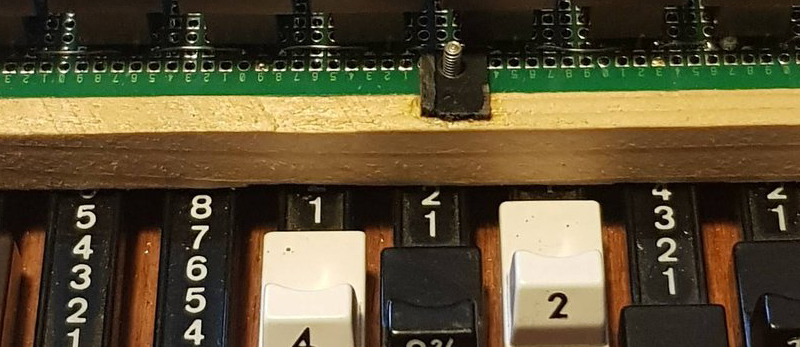This goes back to Bach: if you want to change the sound an organ makes, you have to pull on some drawbars. This design didn’t change for 300 years, and in the 20th century with the advent of ‘tonewheel’ organs, you still had small bars to pull to change what sounds came out of the organ. While this was a simple solution for air-powered organs of the 1700s, when it comes to MIDI, rotary pots are a lot less expensive than linear pots. Given the lack of drawbar MIDI controllers, [Stefano] decided to build his own. It has nine drawbars and eight buttons, all connected to MIDI.
The interesting electromechanical part of this build, the drawbars themselves, are ripped from a Hammond organ. Don’t worry, plenty of these were made and only a handful actually sound good. To that, [Stefano] added a few pushbuttons soldered onto a piece of perfboard, and everything is wired up to a Teensy LC, the microcontroller platform that’s becoming the standard for everything from MIDI controllers to computer keyboards. MIDI over DIN and MIDI over USB are supported, and all the buttons and drawbars are individually programmable. You can even do that through SysEx messages, because that’s how things were done back in the day.
While there are a few MIDI-controlled organs that still use drawbars — the double manual Nord comes to mind imminently — this is a great solution to putting drawbars into anything that speaks MIDI, VSTs included.
















What a terrible article. Brian can’t even be bothered to describe what a drawbar is, or how one works on a pipe organ. Maybe it’s because he doesn’t know?
What a terrible article. Brian can’t even be bothered to describe what a microcontroller is, or how one works. Maybe it’s because he expects people to have the trivial capacity to look things up for themselves?
Still better than your comment, though!
It’s not Brian’s fault if he didn’t even give you half a bar.
Ok, maybe some research would be required before writing about things one doesn’t directly knows. Drawbars, to begin with, were never used in pipe organs; they’re a Hammond thing.
https://github.com/ZioGuido/GMLAB_D9X
https://github.com/ZioGuido/Crumar_D9U
Or you can order a kit from Crumar, an Italian keyboard maker. They make a really nice, ’70s looking (with woodgrain sides!) digital organs too. But you could order a kit from them with all new components and follow the instructions.
Draw stops go back to Roman or earlier times, they are just on off. Drawbars are variable or at least switched on an eight state level.
‘Promote Teensy at all costs!’ One gets that feel….
A project you can really pull out all the stops on.
Now scan 128 sliders and interface to ZynAddSubFX for it’s additive synthesis engine. That’s 6 octaves of harmonic buildup! ZynAdd.. the free synth now runs on Linux or so they say. Will try.